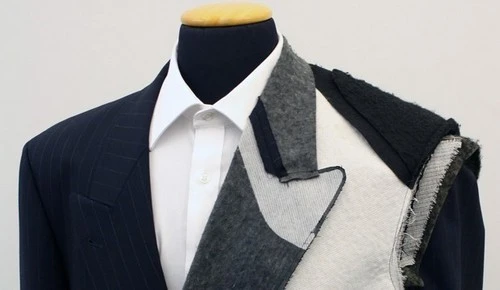Interlining in Garments | Types, Advantages, and Disadvantages of Interlining
Interlining in Garments
A piece of fabric used in between two plies of fabric of a garment component to increase the attractiveness, shape, and strength of that component is called interlining. It is one of the trims used in the garments industry. The materials used for the manufacturing of interlining may be woven, knitted, or felted fabric made from cotton, polyester, nylon, etc. fibers, or their blends. In this article, we discuss details of Interlining in Garments; Different Types of Interlining, and Its advantages, and disadvantages of Interlining.

Types of Interlining in Garments
Interlining is mainly two types:
- Sewn interlining
- Fusible interlining
1. Sewn Interlining
Sewn interlining is also called non-fusible interlining. It is a very old interlining and nowadays very rarely used for the manufacturing of ready-made garments. As because of its availability, cost, performance, etc. appeared is not favorable for the present needs of the garment sector.
Advantages of Sewn Interlining:
- To make flame-retardant garments.
- Simple and easy technique.
- No elaborate machine is required.
- Possible to use in steel or re-rolling or highly heated industry.
Disadvantages of Sewn Interlining:
- Quality is not good.
- Not suitable for large production.
- Not available in the market so we need to prepare it.
- More time is required.
- High workload and labor cost.
2. Fusible Interlining:
The interlining which is attached to the garment component by the application of temperature and pressure is called fusible interlining. Fusible interlining is manufactured by using a resin coating of thermoplastic materials on a piece of fabric. When a garment fabric is placed on the coated side of the interlining and by applying temperature and pressure on that part, it is attached or pasted to the garment fabric. During fusing, temperature, pressure, and fusing time should be controlled properly; otherwise the fusing may be defective.
Advantages of Fusible Interlining:
- Less time is required for attaching the interlining;
- Easy to attach, hence no need for a skilled person;
- Consistency of product;
- Attractiveness and performance are better than sewn interlining;
- Sometimes could be used as a work aid;
- Available in the market.
Disadvantages of Fusible Interlining:
- High temperature is required.
- Special care is needed during attaching interlining.
Interlining is an indispensable part of the garment’s clothing. Some parts of clothes need thicker parts, Interlining attaching to the fabric can fulfill it.
- You may love to read: Difference between Lining and Interlining
- Fusing Process Quality inspection in Garments Industry
